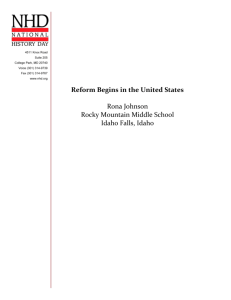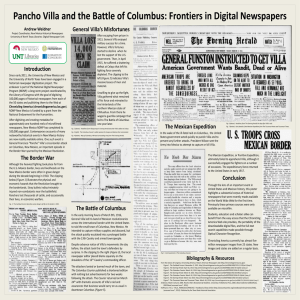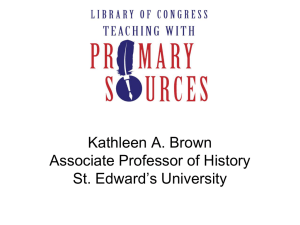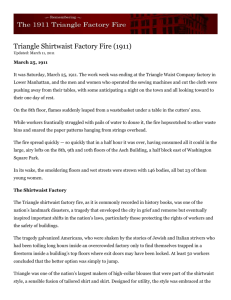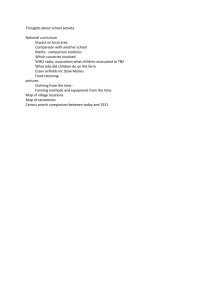Final Research paper
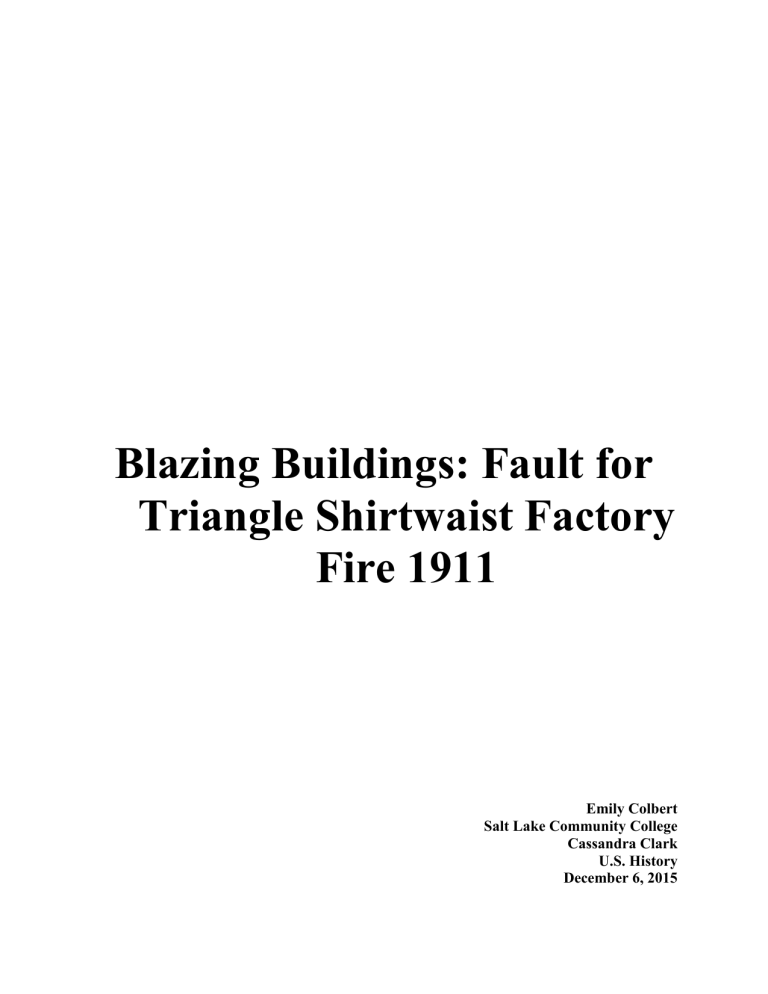
Blazing Buildings: Fault for
Triangle Shirtwaist Factory
Fire 1911
Emily Colbert
Salt Lake Community College
Cassandra Clark
U.S. History
December 6, 2015
“hundreds of flowering girls tucking spring into sleeves, tucking and tugging at spring to stay alive. and the girls were girls not angels jumping, not goddesses flying or hovering they smashed, they broke into large pieces, smell them in the rain.” ~Safiya Henderson-Holmes 1
On March 25 th
1911, more than 140 people died as flames ripped through the Triangle
Shirtwaist Factory 2 . “Accidents” like this took place in factories such as Triangle Shirtwaist
Factory because working conditions were unsafe for all who worked in these factory settings often due to negligence from the building owner, the employer renting the building, government officials, and employees.
Joseph J Asch owner of the Asch Building, which the employees of the Triangle
Shirtwaist Company worked in, installed a cheap fire escape on the outside of the building in order to comply with fire safety code.
3
The fire escape he installed was rickety, and small. The window which the women would have had to climb out in order to reach the fire escape had a metal shutter that swung out. This shutter blocked the way requiring anyone who tried to use the escape to first close the shutter in order to get around it and down the stairway. According to investigators, it would have taken three hours for all seven hundred employees (500 women) to make it down the one fire escape.
4
Upon further investigation of the fire, Fire Marshal Beeres informed the press that fire drills never happened in the facility.
5
Because the owners neglected to consistently have fire drills, there would have been no way for them to know how long a full evacuation of the building would take on a good day. Also, the probability of the workers sensing the real danger was
decreased. Many likely took some time to wrap their mind around the idea of a fire in the workplace.
When asked by Judge Crain in a trial what her first intimation that there was a fire, May
Levantini said, “When I opened the door.” 6
Upon further examining it was found that she had no knowledge about there being a fire before walking straight towards it. She even goes as far as to say she didn’t know there was a fire, “until I looked over the railing and saw flames and smoke.” 7 If it took more time for people on the higher floors to learn about the fire it would allow the flames to build up in size and make an eventual escape less expected. The New York
Tribune says that the 9 th
floor was the deadliest of all and as of the 29 th
of March 1911 there was only one confirmed female survivor.
8
Some New York University students sat on the sideline watching as women tried to use this fire escape to flee to safety, but according to the students none of the women who tried to flee this way made it to safety.
9
Some fell over the edge of the escape while others fell to their death when the fire escape collapsed underneath their weight.
10
Had this fire escape been properly mounted and maintained, or a third set of stairs installed, many of those lives could have been saved. Asch claimed that he was never told to install anymore stairs in the building and that he was never told the building was not properly equipped for emergencies.
11
The owner of the building also claimed his building to be “fireproof”.
12
This would have allowed employees and businessmen such, as the owners of the company, to become less concerned about the possibility of a disaster happening. The building was indeed “Fireproof”.
After the fire was put out, the building itself was fully intact and hardly damaged at all.
13
Everything inside of the building, however, was flammable.
Max Blanck, owner and employer of the Triangle Shirtwaist Factory, would claim after the fire that there were strict orders against smoking in the lofts.
14 Even with this in place some of the young cutters were known for smoking just before getting off clock. This may have been in part due to the fact that they assumed the building safe because it was known to be
“fireproof”, and also in part to de-stress from a long day of working. Reporters found a burnt cigarette case in charred remains of the fire and around the bodies of the men who jumped were matches likely used to light their cigarettes.
15 Nellie Ventura, about 18, backs up reporters’ claims when she says, “you know, some of the boys that work there used to smoke cigarettes in the hallways.” 16
According to the city’s Fire Chief Crocker, it was likely that a carelessly discarded cigarette or match started the fire.
17
The Factory owners, Max Blanck and Isaac Harris, were no better when it came to negligence in the pre-fire workplace. Even though nine tenths of their workers did not speak fluent English and most of the women employed through them only spoke Yiddish and Italian,
Blanck and Harris did not install exit signs in their employees’ native languages.
18
The only signs in the building were written in English.
19
Even if these signs were written in words the workers would easily understand, it would have been rather improbable for these women to escape. Josie Nicolosi and Rossie Passantine, two girls employed through Triangle Shirtwaist claimed that the door to the street level was locked.
20
If this was really the case, Blanck and Harris were in direct violation of the Section 80 of the Consolidated Laws stated that “All doors leading in or to any such factory shall be so constructed as to open outwardly where practicable and shall not be locked, bolted or fastened during working hours.” 21 One reason they locked the doors, according to the girls, was to prevent theft.
22
The girls also say a wooden partition obstructed their way to the exits.
23
In the Building code, Section 103, it says, “No person shall at any time place any encumbrance of any kind whatsoever before or upon any fire escape, balcony, or ladder.”
24
This means yet another requirement was not followed by Blanck and Harris. At the end of the day, all women were required to be herded out through the partition, which only two girls through at a time.
25
The owners set it up this way so they could monitor as people left. They required a search of every purse at the end of the day.
26 However, there was at least one other account that said the doors were unlocked on the day in question.
27
The water tank on top of the building was also empty according to The Yakima Times.
28
This means that even if the girls could make it to the roof there was no way of putting out the fire around or possibly even on them.
Owners of these big factories had, for many years, ignored the pleas of their workers. Mr.
Maley, representative of the Ladies’ Waist makers’ Union, said that a strike took place in the
Triangle Shirtwaist Factory for the more humane treatment of their coworkers and selves only one year before the fire.
29
The Triangle Shirtwaist Company resisted the protesters with violence, and lockouts.
30
The workers won a small victory in getting a slight pay raise and insignificant decrease in hours however lost their right to organize unions.
31 One article says, “News accounts of the fire note the ironic coincidence that the same police who had arrested and clubbed striking waistmakers the previous winter were now piling the bodies into coffins.” 32
New York law required 250 cubic feet of air per employee.
33
Company owners got away with packing people in closer by having high ceilings and counting the space above their head. If government officials decided not allowed this practice, there would be less people to evacuate
from any building during an emergency. As such, the death toll in any emergency would be significantly reduced not only because less people would be in the same room but also because there would be less likelihood of people being pushed and shoved as everyone tried to fit in the same space all at once.
Had government officials been more active in enforcing city laws, many of these previously mentioned situations could have been prevented. Even District Attorney Whitman was unsure as to the amount of time and effort officials had taken to passing and upholding workplace laws when he said, “Perhaps the laws are not drastic enough; possibly such laws are not rigidly enforced; At any rate it will be essential, I think, for the grand jury to spread before the public the exact situation. If the right kind of laws are lacking, public opinion will get them.
If the laws haven’t been enforced may be able to find out who is to blame.” 34
Because of movements like The Ladies’ Waist Makers’ Union, calling society to a reform and turning up the heat on careless actions laws would become more important in the workplace.
This specific union constructed a committee consisting of three people: Miles M. Dawson,
Algernon Lee and Morris Hillquit.
35 It was their duty to write a resolution to give to the press. In their preamble they claim, “It is most evident that there has been neglect on the part of many, both officials and private citizens, and especially lack of cooperation to prevent such accidents, and that such neglect is immediately the cause of this most deplorable affliction.”
36
They state that if nothing is done about working conditions that their “Brothers and sisters” will have died in vain, and call out all parties involved in overlooking their responsibilities. Further in the document the men write, “We who are here assembled deplore and condemn the blindness of public officials who fatuously permit such conditions to continue, the greed of such employers as
do not welcome but instead punish without dismissal employees who demand safe conditions under which to work.” 37
While this kind of neglect happened not only in this one instance most of them did not turn disastrous; however, they had the potential to do so. Whitman also said about the incident,
“Fire Chief Crocker tells me that the shocking conditions at the Asch building are duplicated all through the factory district and that it has been impossible for him, despite numerous appeals and protests, to make any headway. Fire Commissioner Waldo agrees absolutely with his subordinate.”
38
Who is to blame for the countless senseless deaths in the Triangle Shirtwaist Fire?
Perhaps it was the young cutter who carelessly through his cigarette aside, or the owners who locked their employees in during working hours to prevent theft. Possibly it is the fault of the building owner who so carelessly threw up faulty safety equipment doing the bare minimum to pass inspection, or the city officials who would only glance over the building instead of thoroughly inspect it. One of these on its own could not have caused such a tragedy. The combined neglect from all involved in incidences like this would eventually lead America to the safety laws we now have in place.
Notes
1.
Janet Zandy, College Literature, 24 Vol. (Maryland: John Hopkins University, 1997), 48.
2.
Nancy J Barrett, OAH Magazine of History, 13 Vol. (New York: Oxford University, 1999), 43.
3.
”Only Fire escape in New York Sweatshop Fire was a Fire Trap.”
Tacoma Times, April 4, 1911
4.
“Not a Chance for the Girls,”
The Yakima Herald, March 29, 1911, accessed December 5, 2015, http://chroniclingamerica.loc.gov/lccn/sn88085523/1911-03-29/ed-1/seq-6/;words=CHANCE+GIRLS .
5.
“Not a Chance for the Girls,” The Yakima Herald, March 29, 1911, accessed December 5, 2015, http://chroniclingamerica.loc.gov/lccn/sn88085523/1911-03-29/ed-1/seq-6/;words=CHANCE+GIRLS .
6.
“Saw Factory Door Open,” The New York Tribune, Dec 20, 1911, accessed December 5, 2015, http://chroniclingamerica.loc.gov/lccn/sn83030214/1911-12-20/ed-1/seq-
14/;words=Witnesses+Fire+Defence+Triangle+Help .
7.
“Saw Factory Door Open,” The New York Tribune, Dec 20, 1911, accessed December 5, 2015, http://chroniclingamerica.loc.gov/lccn/sn83030214/1911-12-20/ed-1/seq-
14/;words=Witnesses+Fire+Defence+Triangle+Help
8.
“Girls Swear Door was Locked, Another Blocked,”
The New York Tribune, March 29,1911, accessed December 5,
2011, http://chroniclingamerica.loc.gov/lccn/sn83030214/1911-03-29/ed-1/seq-
1/;words=Disaster+Survivor+Confirm+Factory+Reports+Survivors
9.
“Only Fire Escape in New York Sweat Shop was Fire Trap,” The Tacoma Times, April 4, 1911, Accessed December 5,
2015 , http://chroniclingamerica.loc.gov/lccn/sn88085187/1911-04-04/ed-1/seq-7/;words=Fire+fire+escape+Escape .
10.
“ Only fire escape in New york sweat shop was fire trap,” The Tacoma Times, April 4, 1911, Accessed December 5,
2015 , http://chroniclingamerica.loc.gov/lccn/sn88085187/1911-04-04/ed-1/seq-7/;words=Fire+fire+escape+Escape .
11.
“Cigarette Caused the Factory Fire,” The New York Tribune, March 27, 1911, Accessed December 5, 2015, http://chroniclingamerica.loc.gov/lccn/sn83030214/1911-03-27/ed-1/seq-1/;words=FIRE+New+FACTORY+NEW-
YORK+York
12.
“Cigarette Caused the Factory Fire,” The New York Tribune, March 27, 1911, Accessed December 5, 2015, http://chroniclingamerica.loc.gov/lccn/sn83030214/1911-03-27/ed-1/seq-1/;words=FIRE+New+FACTORY+NEW-
YORK+York
13.
“New York Horror to be probed,” The Democratic Banner, March 28, 1911, Accessed December 5, 2015, http://chroniclingamerica.loc.gov/lccn/sn88078751/1911-03-28/ed-1/seq-
1/;words=Waist+fire+waist+factory+Fire+waists+NEW+New+York .
14.
“New York Horror to be probed,” The Democratic Banner, March 28, 1911, Accessed December 5, 2015, http://chroniclingamerica.loc.gov/lccn/sn88078751/1911-03-28/ed-1/seq-
1/;words=Waist+fire+waist+factory+Fire+waists+NEW+New+York .
15.
“New York Horror to be probed,” The Democratic Banner, March 28, 1911, Accessed December 5, 2015, http://chroniclingamerica.loc.gov/lccn/sn88078751/1911-03-28/ed-1/seq-
1/;words=Waist+fire+waist+factory+Fire+waists+NEW+New+York
16.
“Girls Swear Door was Locked, Another Blocked,”
The New York Tribune, March 29,1911, accessed December 5,
2011 , http://chroniclingamerica.loc.gov/lccn/sn83030214/1911-03-29/ed-1/seq-
1/;words=Disaster+Survivor+Confirm+Factory+Reports+Survivors
17.
“Cigarette Caused the Factory Fire,”
The New York Tribune, March 27, 1911, Accessed December 5, 2015, http://chroniclingamerica.loc.gov/lccn/sn83030214/1911-03-27/ed-1/seq-1/;words=FIRE+New+FACTORY+NEW-
YORK+York
18.
“Not a Chance for the Girls,”
The Yakima Herald, March 29, 1911, accessed December 5, 2015, http://chroniclingamerica.loc.gov/lccn/sn88085523/1911-03-29/ed-1/seq-6/;words=CHANCE+GIRLS .
19.
“Not a Chance for the Girls,” The Yakima Herald, March 29, 1911, accessed December 5, 2015, http://chroniclingamerica.loc.gov/lccn/sn88085523/1911-03-29/ed-1/seq-6/;words=CHANCE+GIRLS
20.
“Girls Swear Door was Locked, Another Blocked,” The New York Tribune, March 29,1911, accessed December 5,
2011, http://chroniclingamerica.loc.gov/lccn/sn83030214/1911-03-29/ed-1/seq-
1/;words=Disaster+Survivor+Confirm+Factory+Reports+Survivors .
21.
“Girls Swear Door was Locked, Another Blocked,”
The New York Tribune, March 29,1911, accessed December 5,
2011, http://chroniclingamerica.loc.gov/lccn/sn83030214/1911-03-29/ed-1/seq-
1/;words=Disaster+Survivor+Confirm+Factory+Reports+Survivors Ibid.
22.
Ibid.
23.
Ibid.
24.
Ibid.
25.
Ibid.
26.
Ibid.
27.
Ibid.
28.
“Not a Chance for the Girls,” The Yakima Herald, March 29, 1911, accessed December 5, 2015, http://chroniclingamerica.loc.gov/lccn/sn88085523/1911-03-29/ed-1/seq-6/;words=CHANCE+GIRLS
29.
“Labor Condemns Horror,” The New York Tribune, March 27, 1911, Accessed December 5, 2015, http://chroniclingamerica.loc.gov/lccn/sn83030214/1911-03-27/ed-1/seq-4/;words=Blame+Twenty+Organizations .
30.
Janet Zandy, College Literature, 24 Vol. (Maryland: John Hopkins University, 1997), 37.
31.
Janet Zandy, College Literature, 24 Vol. (Maryland: John Hopkins University, 1997), 37.
32.
Janet Zandy, College Literature, 24 Vol. (Maryland: John Hopkins University, 1997), 37.
33.
Janet Zandy, College Literature, 24 Vol. (Maryland: John Hopkins University, 1997), 37.
34.
“New York Horror to be probed,” The Democratic Banner, March 28, 1911, Accessed December 5, 2015, http://chroniclingamerica.loc.gov/lccn/sn88078751/1911-03-28/ed-1/seq-
1/;words=Waist+fire+waist+factory+Fire+waists+NEW+New+York .
35.
“Labor Condemns Horror,” The New York Tribune, March 27, 1911, Accessed December 5, 2015, http://chroniclingamerica.loc.gov/lccn/sn83030214/1911-03-27/ed-1/seq-4/;words=Blame+Twenty+Organizations .
36.
“Labor Condemns Horror,”
The New York Tribune, March 27, 1911, Accessed December 5, 2015, http://chroniclingamerica.loc.gov/lccn/sn83030214/1911-03-27/ed-1/seq-4/;words=Blame+Twenty+Organizations .
37.
Ibid .
38.
“New York Horror to be probed,” The Democratic Banner, March 28, 1911, Accessed December 5, 2015, http://chroniclingamerica.loc.gov/lccn/sn88078751/1911-03-28/ed-1/seq-
1/;words=Waist+fire+waist+factory+Fire+waists+NEW+New+York .
BIBLIOGRAPHY
PRIMARY SOURCES
The Democratic Banner,
“New York Horror to be Probed.” Mar 28,1911. From Library of
Congress. Web. http://chroniclingamerica.loc.gov/lccn/sn88078751/1911-03-28/ed-1/seq-
1/;words=Waist+fire+waist+factory+Fire+waists+NEW+New+York (Accessed
December 5, 2015).
The New York Tribune, “Cigarette Caused Factory Fire.”Mar 27, 1911. From Library of
Congress. Web. http://chroniclingamerica.loc.gov/lccn/sn83030214/1911-03-27/ed-1/seq-
1/;words=FIRE+New+FACTORY+NEW-YORK+York (Accessed December 5, 2015).
The New York Tribune,
“Girls Swear Door Locked, Another Block.” Mar 29, 1911. From
Library of Congress. Web. http://chroniclingamerica.loc.gov/lccn/sn83030214/1911-03-
29/ed-1/seq-1/;words=Disaster+Survivor+Confirm+Factory+Reports+Survivors
(Accessed December 5,2015).
The New York Tribune, “Labor Condemns Horror.” Mar 27, 1911. From Library of Congress.
Web. http://chroniclingamerica.loc.gov/lccn/sn83030214/1911-03-27/ed-1/seq-
4/;words=Blame+Twenty+Organizations (Accessed December 5, 2015).
The New York Tribune, “Saw Factory Door Open.” Dec 20, 1911. From Library of Congress.
Web. http://chroniclingamerica.loc.gov/lccn/sn83030214/1911-12-20/ed-1/seq-
14/;words=Witnesses+Fire+Defence+Triangle+Help (Accessed December 5, 2015).
The Tacoma Times,
“Only Fire Escape in New York Sweatshop Fire was a Fire Trap.” Apr 4,
1911. From Library of Congress. Web. http://chroniclingamerica.loc.gov/lccn/sn88085187/1911-04-04/ed-1/seq-
7/;words=Fire+fire+escape+Escape (Accessed December 5, 2015).
The Yakima Herald,
“Not a Chance for the Girls.” Mar 29,1911. From Library of Congress.
Web. http://chroniclingamerica.loc.gov/lccn/sn88085523/1911-03-29/ed-1/seq-
6/;words=CHANCE+GIRLS (Accessed December 5, 2015).
SECONDARY SOURCES
Barrett, Nancy J.. 1999. “The Struggles of Women Industrial Workers to Improve Work
Conditions in the Progressive Era”.
OAH Magazine of History 13 (3). [Oxford University
Press, Organization of American Historians]: 43–49. http://www.jstor.org.libprox1.slcc.edu/stable/25163292 .
Zandy, Janet. 1997. “Fire Poetry on the Triangle Shirtwaist Company Fire of March 25, 1911”.
College Literature 24 (3). College Literature: 33–54. http://www.jstor.org.libprox1.slcc.edu/stable/25112327.
